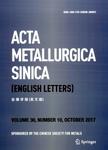Study of lithium storage properties of the Sn-Ni alloys prepared by magnetic sputtering technology
Study of lithium storage properties of the Sn-Ni alloys prepared by magnetic sputtering technology作者机构:School of Physics and Telecommunication Engineering South China Normal University Guangzhou 510006 China
出 版 物:《Acta Metallurgica Sinica(English Letters)》 (金属学报(英文版))
年 卷 期:2010年第23卷第5期
页 面:363-369页
核心收录:
学科分类:080503[工学-材料加工工程] 07[理学] 08[工学] 0805[工学-材料科学与工程(可授工学、理学学位)] 0701[理学-数学] 070101[理学-基础数学]
基 金:supported by the National Natural Science Foundation of China(No.50771046) the authors would like to thank Prof. Weishan LI for beneficial suggestions
主 题:Lithium ion battery Sn-Ni alloy Electrochemical property
摘 要:Nano-level Sn-Ni alloy thin-film electrode materials prepared by magnetic sputtering technology are characterized with X-ray diffraction (XRD), atom force microscopy (AFM) and scanning electron microscopy (SEM). The charge/discharge and cyclic voltammograms (CV) of the films electrodes are tested by the battery testing system of high precision. The results indicate that the materials prepared by direct current (DC) and radio frequency (RF) methods differ greatly in their performance. Ni3Sn2 alloy phase constitutes the main components prepared by DC method, the particles on the surface are tiny and show steady cycling performance, the deficiency is that they have low initial efficiency and small discharge capacity of 72% and 108 mA·h/g, respectively. Contrary to the former, Ni3Sn4 alloy phase constitutes the main com- ponents prepared by RF method, the particles on the surface appear comparatively larger, their discharge capacity did not decline in the first 15 times, keeping above 500 mA·h/g, but began to decline after 15 times.



